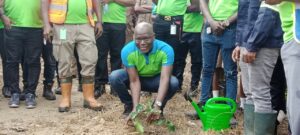Bui Power Authority calls for concerted efforts to build a climate resilient society
 Mr Samuel Kofi Dzamesi, the Chief Executive Officer (CEO) of the Bui Power Authority (BPA) has called for concerted efforts towards building a climate resilient society to mitigate the impact of climate change in the country.
Mr Samuel Kofi Dzamesi, the Chief Executive Officer (CEO) of the Bui Power Authority (BPA) has called for concerted efforts towards building a climate resilient society to mitigate the impact of climate change in the country.
He said the water sector in Ghana was one of the major areas that was and would be impacted by climatic change, hence the need to build climate resistant society, saying policy makers, planners and managers could no longer rely on the past climatic conditions.
Mr Dzamesi made the call in a speech read on his behalf by Mr Maxwell Wumbilla Salifu, the Director of Estates of the BPA, managers of the Bui Power Generating Station (BGS) at a tree planting exercise to mark the Green Ghana Day (GGD) project held at Bui in the Banda District of the Bono Region.
The Authority is planting about 20,000 tree species including teak, acacia, mahogany and Cedrela in addition to other economic trees such as mango, guava, citrus and coconuts around the 400 megawatts dam’s enclave and its resettlement communities.
Mr Dzamesi explained the BPA as renewable energy leaders in the Sub-region was conscious of the impact climate change played on hydropower generation, hence he added the Authority had developed and implementing a ‘Forest Resource Enhancement Program (FREP)’ around the Bui and the Tsatsadu Generating Stations to ameliorate the threats.
He said energy remained an important ingredient that supported all facets of life in the world today with emphasis on cleaner and renewable sources due to the growing threats of global warming because of climate change.
“This is in line with the 17 United Nations Sustainable Development Goals which Goal Seven advocates for universal access to affordable, reliable and modern energy services whiles Goal 13 advises us on the need to take urgent action to combat climate change and its impacts,” Mr. Dzamesi said.
Throwing more light on the FREP, Mr Chrisentus Kuunifaa, Deputy Director, Occupational Health, Safety and Environment of BPA said the formation of the Bui Reservoir created a lake, covering up to 444 km2 of landmass at its full supply level of 183 metres above sea level.
He said most of these land areas were gallery forest and savannah woodlots, saying the formation of the reservoir had therefore contributed to the depletion of forest resources in some areas.
“Furthermore, experience after the creation of the Volta Lake in 1964, showed that, anthropogenic factors such as adoption of inappropriate farming methods, bush burning, illegal logging, cattle grazing, fish smoking and sand winning increased rapidly and considerably within the Volta Basin,” Mr Kuunifaa said.
Thus, these inimical activities caused rapid forest depletion and the tendencies of accelerated soil erosion, siltation, and sedimentation, with a resultant adverse impact on climatic conditions within the Basin.
Mindful of these consequences, Mr Kuunifaa said the BPA FREP, which was a flagship programme was designed to promote reforestation activities and the conservation of the natural forest within the BGS region of influence and other BPA operational areas.
“Since climate change is imminent and being exacerbated by land degradation from anthropogenic activities, the FREP concept was mooted and rolled out in 2012 to offset and mitigate these impacts arising.
The FREP is one of the BPA’s primary climate change mitigation tools being implemented on the Acquired Land within the Black Volta Basin and the Tsatsadu GS environs now which involved in two main elements - reforestation and afforestation activities as well as the conservation of gallery forests and savannah woodlots”, he added.
Mr Kuunifaa said the FREP initiative was encouraging massive tree planting throughout the Black Volta Basin and other BPA operational areas, thus enhancing the hydrological cycle within catchment areas to increase precipitation, protecting the lakeshores against siltation, sedimentation and other inimical activities that had the tendency to eutrophication, nitrogen and phosphates loading (to ensure sustainable power generation from the BGS).
Mr Kuunifaa said the initiative commenced in 2012 on a pilot scheme and had since planted about 172 hectares of plantation around the Bui Dam enclave.
Source: GNA
